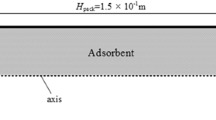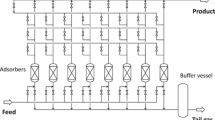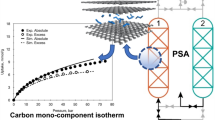Abstract
Pressure Swing Adsorption process is a discrete–continuous system by nature and it is extremely time consuming to simulate steady state performance for a given set of design and operating parameters. A multitude of design variations is offered by the configuration of Pressure Swing Adsorption cycle in terms of choice, sequence, and durations of various possible component steps implemented on two or more adsorber beds. Often, simplifying assumptions are made to speed up each simulation. These assumptions erode the quality of match between reality and simulation and make the resultant design approximate. Use of assumptions like no adsorption/desorption during the pressurization and blowdown steps, constancy in volumetric flow during the adsorption and purge steps makes the model computationally lighter but raises questions on its predictive power. A new modeling approach, namely Multi-cell Model is presented in this work. It is shown to avoid the extensive time taken with equation-based simulations and to have better predictive power. The model is used to study a representative Pressure Swing Adsorption process for nitrogen enrichment from the air. Numerical convergence with respect to the spatial and temporal step sizes and mass balance closure is verified. The model is generic in nature and is valid for any multi-bed, multi-adsorbent, multi-component Pressure Swing Adsorption process executing any combination of component steps.












Similar content being viewed by others
Abbreviations
- Ab :
-
Cross-sectional area of the bed (m2)
- bi :
-
Langmuir isotherm constant of ith component (m3/mol)
- C3 :
-
Third component in the study
- Cv :
-
Valve coefficient (unit-less)
- db :
-
Diameter of bed (m)
- dp :
-
Particle diameter (m)
- D:
-
Distribution coefficient
- e:
-
Tolerance level used in the CSS determination
- ki LDF :
-
LDF coefficient of component ‘i’ (1/s)
- L:
-
Height of the adsorbent in the bed (m)
- ∆Lk :
-
Height of kth L-cell (m)
- Lfeed :
-
Height of bed up to which feed is present (m)
- m:
-
Total number of cells in the bed (Multi-cell Model)
- M:
-
Total number of temporal divisions
- n:
-
Number of component
- Nk :
-
Total number of moles present kth cell
- Pbed :
-
Pressure in the after IBPE
- Pk :
-
Pressure in kth cell (bar)
- qi :
-
Solid phase concentration of ith component (mol/m3 of adsorbent)
- qs :
-
Monolayer saturation capacity of components (mol/m3 of adsorbent)
- q* :
-
Adsorption equilibrium concentration of ‘ith’ component in the solid (m3/mol)
- R:
-
Ideal gas law constant (J/mol/k)
- t:
-
Duration of a PSA step (s)
- ∆t:
-
Size of time step, used in multi-cell modeling (s)
- T:
-
Operating temperature (K)
- u:
-
Superficial linear velocity of the mixture in the bed (m/s)
- Vads :
-
Volume of adsorbent (m3)
- Vbulk :
-
Bulk volume, void volume (m3)
- ∆x:
-
Height of bed that holds unit mole of gas in bulk phase (m)
- yi :
-
Bulk phase mole fraction of ith component (unit-less)
- ∆Zk :
-
Height of kth Z-cell (m)
- ads:
-
Adsorbent phase
- f:
-
Feed
- i:
-
Index used for component, ‘1’ means strongly adsorbing component
- in:
-
Inlet stream
- j:
-
Index for temporal positions
- k:
-
Index for spatial position
- out:
-
Outlet
- r:
-
Raffinate
- γ:
-
Cycle index
- ρ:
-
Density of the fluid mixture (kg/m3)
- ρp :
-
Density of the particle (kg/m3)
- CMS:
-
Carbon molecular sieve
- CSS:
-
Cyclic steady state
- DE:
-
Desorption to extract
- DR:
-
Desorption to raffinate
- FA:
-
Feed adsorption
- IBPE:
-
Instantaneous bulk phase pressure equalization
- ID:
-
Incubation
- PE:
-
Pressure equalization
- PF:
-
Feed pressurization
- PR:
-
Pressurization with raffinate
- RP:
-
Raffinate purge
References
Agarwal, A., Biegler, L.T., Zitney, S.E.: A superstructure-based optimal synthesis of PSA cycles for post-combustion CO2 capture. AIChE J. 56, 1813–1828 (2010)
Biegler, L.T., Jiang, L., Fox, V.G.: Recent advances in simulation and optimal design of pressure swing adsorption systems. Sep. Purif. Rev. 33, 1–39 (2004)
Chan, Y.N.I., Hill, F.B., Wong, Y.W.: Equilibrium theory of a pressure swing adsorption process. Chem. Eng. Sci. 36, 243–251 (1981)
Farooq, S., Ruthven, D.M., Boniface, H.A.: Numerical simulation of a pressure swing adsorption oxygen unit. Chem. Eng. Sci. 44, 2809–2816 (1989)
Hassan, M.M., Ruthven, D.M., Raghavan, N.S.: Air separation by pressure swing adsorption on a carbon molecular sieve. Chem. Eng. Sci. 41, 1333–1343 (1986)
Knaebel, K.S., Hill, F.B.: Pressure swing adsorption: development of an equilibrium theory for gas separations. Chem. Eng. Sci. 40, 2351–2360 (1985)
Levenspiel, O.: Chemical reaction engineering. Wiley, New Jersey (1972)
Liu, Z., Grande, C. a., Li, P., Yu, J., Rodrigues, A.E.: Multi-bed vacuum pressure swing adsorption for carbon dioxide capture from flue gas. Sep. Purif. Technol. 81, 307–317 (2011)
Mhaskar, P.R., Moharir, A.S.: Multi-component adsorptive separation: use of lumping in PSA process simulation. Adsorption 17, 701–721 (2011)
Mhaskar, P.R., Moharir, A.S.: Natural gas treatment using adsorptive separation. INTECH (2012)
Mhaskar, P.R., Peter, S.A., Moharir, A.S.: Generic mathematical model for PSA process. Chem. Prod. Process Model (2012). Doi:10.1515/1934-2659.1574
Nilchan, S., Pantelides, C.C.: On the optimisation of periodic adsorption processes. Technology 147, 113–147 (1998)
Rajasree, R., Moharir, A.S.: Simulation based synthesis, design and optimization of pressure swing adsorption (PSA) processes. Comput. Chem. Eng. 24, 2493–2505 (2000)
Satyanjay, S., Moharir, A.S.: Simulation-based PSA process designer. FOA 11 (2013)
Shendalman, L.H., Mitchell, J.E.: A study of heatless adsorption in the model system CO2 in He, I. Chem. Eng. Sci. 27, 1449–1458 (1972)
Sircar, S.: Pressure swing adsorption. Ind. Eng. Chem. Res. 41, 1389–1392 (2002)
Satyanjay, S., Moharir, A.S.: Simulation-based PSA Process Designer. In: FOA 11 (2013)
Author information
Authors and Affiliations
Corresponding author
Electronic supplementary material
Below is the link to the electronic supplementary material.
Rights and permissions
About this article
Cite this article
Sahoo, S., Shukla, A. & Moharir, A.S. Multi-cell model for pressure swing adsorption process. Adsorption 23, 515–534 (2017). https://doi.org/10.1007/s10450-017-9865-6
Received:
Revised:
Accepted:
Published:
Issue Date:
DOI: https://doi.org/10.1007/s10450-017-9865-6




